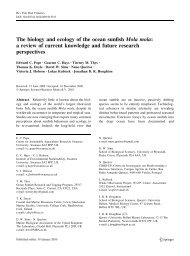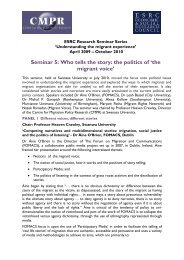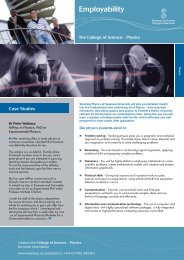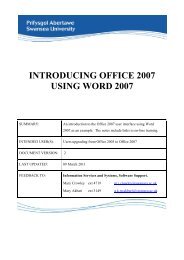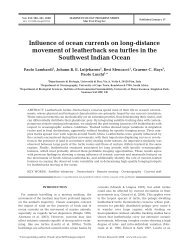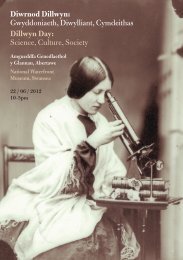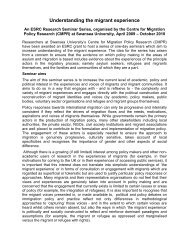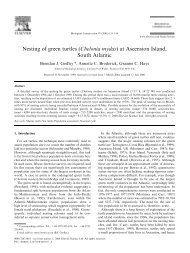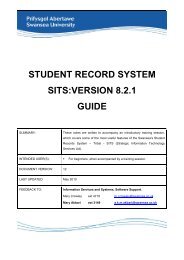The energy density of jellyfish - Swansea University
The energy density of jellyfish - Swansea University
The energy density of jellyfish - Swansea University
Create successful ePaper yourself
Turn your PDF publications into a flip-book with our unique Google optimized e-Paper software.
246 T.K. Doyle et al. / Journal <strong>of</strong> Experimental Marine Biology and Ecology 343 (2007) 239–252<br />
3.1.2. Energy <strong>density</strong> from bomb-calorimetry<br />
Mean gross <strong>energy</strong> <strong>density</strong> estimates obtained using<br />
bomb-calorimetry ranged from 2.14 to 3.73 kJ g DM − 1 ,<br />
for whole <strong>jellyfish</strong> (Table 3). <strong>The</strong>re was a significant<br />
difference in GE between species, with C. capillata<br />
having a higher mean GE content (3.73 kJ g DM − 1 ) than<br />
the two other species (ANOVA: F 2, 17 =9.53, pb0.01).<br />
Within species, there were significant differences<br />
between the GE <strong>of</strong> the different tissues. In the case <strong>of</strong><br />
C. capillata the bell tissue had significantly lower<br />
<strong>energy</strong> <strong>density</strong> (mean: 1.45 kJ g DM − 1 ) than both the<br />
gonad (mean: 6.67 kJ g DM − 1 ) and oral arm (mean:<br />
7.04 kJ g DM − 1 ) tissues (ANOVA: F 2, 22 =46.09,<br />
pb0.01) (Table 3). With C. hysoscella, the gonads had<br />
significantly higher <strong>energy</strong> content (mean: 4.95 kJ g<br />
DM − 1 ) than both oral arm (mean: 2.22 kJ g DM − 1 )<br />
and bell (mean: 1.01 kJ g DM − 1 ) tissues (ANOVA:<br />
F 2, 26 =34.15, pb0.01). In a similar fashion, the<br />
gonad tissue <strong>of</strong> R. octopus had significantly higher<br />
<strong>energy</strong> content (mean: 5.59 kJ g DM − 1 ) than both<br />
oral arm (mean: 3.62 kJ g DM − 1 ) and bell (mean:<br />
1.87 kJ g DM −1 ) tissues (ANOVA: F 2, 14 =7.88,pb0.01)<br />
(Table 3).<br />
3.1.3. Proximate-composition results<br />
3.1.3.1. Inorganic composition (ash content). <strong>The</strong><br />
mean ash content for whole C. capillata was 67.8%<br />
DM. <strong>The</strong>re was a significant difference between the<br />
ash content <strong>of</strong> the different tissues, where the gonads<br />
and oral arms had a significantly lower ash content<br />
than the bell tissue (ANOVA: F 2, 36 =141.37, pb0.001)<br />
(Table 4). Although the sample size was limited for<br />
R. octopus, the ash content was higher than that <strong>of</strong><br />
C. capillata (Table 4).<br />
3.1.3.2. Organic composition (protein, lipid and<br />
carbohydrate content). Protein was by far the largest<br />
fraction <strong>of</strong> the organic matter present in C. capillata dried<br />
samples, which contained only minor amounts <strong>of</strong> either<br />
lipids or carbohydrates. <strong>The</strong> protein content ranged from<br />
10.1% to 22.6% DM for whole specimens (Table 5), and<br />
varied significantly between the component tissues<br />
(ANOVA: F 2, 30 =249.24, pb0.001). Both the gonads<br />
and oral arms had a far greater protein content than did the<br />
bell component (mean ±S.D. expressed as % DM:<br />
gonads =28.4±3.9, oral arms =29.8±3.1, bell =7.9 ±<br />
Table 4<br />
Ash content values (both measured and revised) for individual tissues <strong>of</strong> C. capillata and R. octopus<br />
Species ID Ash (% DM)<br />
Ash (% DM) revised<br />
#<br />
G OA B W G OA B W<br />
C. capillata 1 – 52.0 (1.22) 67.8 (0.31) – – 58.9 76.7 –<br />
C. capillata 2 – 51.2 (0.43) 68.1 (1.06) – – 58.0 77.1 –<br />
C. capillata 3 57.7 (1.10)⁎⁎ 58.2 (0.20)⁎⁎ 74.9⁎ 68.3 65.3 65.9 84.8 77.4<br />
C. capillata 4 – 59.2 (0.10) 74.8 (0.20)⁎⁎ – – 67.0 84.7 –<br />
C. capillata 6 56.1⁎ 52.3 (0.10)⁎⁎ 75.0 (0.26) 66.6 63.5 59.3 84.9 75.5<br />
C. capillata 8 – 58.8 (0.14) 78.1 (0.13) – – 66.6 88.5 –<br />
C. capillata 9 52.6 (1.40)⁎⁎ 51.4 (0.24) 74.6 (0.30)⁎⁎ 70.2 59.6 58.3 84.5 79.5<br />
C. capillata 10 – – 71.3 (0.32) – – – 80.7 –<br />
C. capillata 11 – 51.5 (0.03) 78.0 (0.06) – – 58.3 88.3 –<br />
C. capillata 13 – – 72.2 (0.45) – – – 81.6 –<br />
C. capillata 14 62.9 (0.26) 59.6 (0.05) 74.3 (0.92) 66.8 71.3 67.5 84.1 75.6<br />
C. capillata 17 – – 70.6 (0.32) – – – 79.9 –<br />
C. capillata 18 50.9 (0.10)⁎⁎ 56.2 (0.47) 75.7 (0.16) 65.6 57.6 63.7 85.7 74.3<br />
C. capillata 19 – 48.5 (0.40)⁎⁎ 72.7 (0.30)⁎⁎ – – 54.9 82.3 –<br />
C. capillata 20 51.5 (0.20)⁎⁎ 58.5 (0.12) 74.2 (0.19) 69.2 58.3 66.2 84.1 78.4<br />
C. capillata 21 – 53.0 (0.31) – – – 60.0 –<br />
C. capillata 22 – – 70.3 (0.65) – – – 79.6 –<br />
C. capillata 24 – 54.0 (0.38) 73.1 (0.15) – – 61.1 82.8 –<br />
C. capillata 27 – 51.9 (0.30) 73.7 (0.30)⁎⁎ – – 58.8 83.4 –<br />
Mean (±S.D.) 55.3 (4.61) 54.4 (3.63) 73.3 (2.90) 67.8 (1.75) 62.6 (5.2) 61.6 (4.1) 83.0 (3.3) 76.8 (2.0)<br />
N 6 15 18 6 6 15 18 6<br />
R. octopus 1 79.7⁎ 72.3 (0.03)⁎⁎ 80.2 (0.20) 75.4 90.3 81.9 90.8 85.4<br />
R. octopus 2 66.1 (0.37) 72.0 (0.85) 75.7 (0.43) 71.8 74.9 81.5 85.7 81.3<br />
R. octopus 3 – 72.4 (0.40) 80.0 (0.07) – – 82.0 90.6 –<br />
Mean (±S.D.) 72.9 (9.57) 72.2 (0.17) 78.7 (2.52) 73.6 (2.59) 82.6 (10.9) 81.8 (0.2) 89.1 (2.9) 83.4 (2.9)<br />
N 2 3 3 2 2 3 3 2<br />
G=gonads, OA=oral arms, B=bell, and W=whole <strong>jellyfish</strong>. All samples were analysed in triplicate unless otherwise indicated (⁎single,<br />
⁎⁎duplicate).



